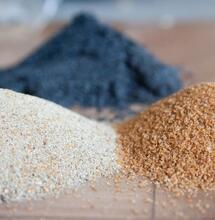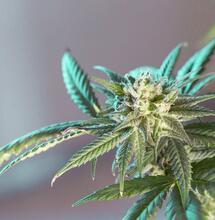Micronutrients: Functions and Feed

Like macronutrients, micronutrients are equally important for the healthy function of cannabis plants. The main difference is you only need trace amounts of these elements to support the healthy nourishment of crops. Below is an overview of the main functions and feed information for micronutrients.
Iron (Fe)
Function: Iron helps plants move oxygen through their systems. Iron helps facilitate chlorophyll production, the green pigment present in all green plants and in cyanobacteria, responsible for the absorption of light, which in turn provides energy for photosynthesis. Iron also plays a vital role in some enzyme functions.
Feed: Cannabis plants only need a tiny amount of Iron, however, it's crucial that this amount is made available to the plant. Iron is the micronutrient that plants require in the most significant amounts compared with other micronutrients.
Outdoor plants source iron from the soil, usually available from the natural breakdown of other plant material. Root systems can also absorb Iron from Ferric oxide, a chemical found in the soil which gives dirt a distinctive reddish nuance. When growing indoors, plants receive their supplement of Iron from the nutrient fertilizers you are using. Plants take up Iron in its oxidized forms Fe+ 2 Ferrous ion or Fe+3 Ferric ion at around 1-1ppm.
Manganese (Mn)
Function: A much-needed trace mineral for all life forms, Мanganese supports critical tasks in cannabis plants, such as photosynthesis, respiration, nitrogen assimilation, pollen germination, root cell elongation, and immune system function.
Feed: Manganese is typically found in minerals together with Iron and never on its own. It is present in soil and some natural water supplies so plants can easily access it in nature. Manganese is included in nutrient feeds used for homegrowing. It is added in the form of manganese sulfate or Mn2+ at about 0.5-1.0ppm. It is the micronutrient required in the second most significant quantity after Iron.
Chloride (Cl−)
Function: Chloride has a direct role in photosynthesis. It controls the function of several enzymes and is essential for osmotic adjustment. Chloride governs the loss of water from stomata, and it supports the circuit of crucial nutrients such as potassium around the plant.
Feed: Chloride is naturally present in soils and sources of water as it's leached from various rocks due to weathering and natural breakdown. Outdoor plants can efficiently uptake chloride with their roots. It is readily available as a mobile element in the soil, and it exists as soluble salts in a water solution. For indoor feed, there's usually no need to worry at all about chloride. Water and other nutrient solutions you might be using contain chloride within other salts (less than 75ppm), which is sufficient to cover your garden.

Copper (Cu)
Function: Copper is needed in tiny quantities as it helps create chlorophyll. This element also supports plant respiration and the processing of carbohydrates and proteins.
Feed: Plants typically supply copper minerals from soluble salts in the soil. In indoor settings, plants receive copper in the form of copper sulfate Cu2+. Cupric sulfate has a broader range of uses for crops, including also as a pesticide and germicide.
Boron (B)
Function: Boron supports cellular processes such as cell wall synthesis and cell division. This element also assists with pollination, seed and fruit development during the plant reproductive growth stage. Boron also helps the transportation of sugars and carbohydrates within the plant. It metabolizes nitrogen, creates proteins, controls hormone levels, transports potassium to the stomata, and helps to maintain internal water balance.
Feed: Outdoor plants absorb Boron from the soil solution where the element deposits naturally from the breakdown of other organic components. Indoor plants receive Boron in the form of boron acid H3BO3 or borate H2BO3 present in feed formulas and sometimes from the source water used to mix the nutrient solution.
Molybdenum (Mo)
Function: With a tricky name to spell, Molybdenum's principal part is boosting nitrogen metabolism in plants. This element supports cannabis plants during flowering and has a role in protecting their health.
Feed: Molybdenum is present in soils with elevated pH levels, however, if your outdoor plants are affected by heavy rainfall, you can assume that this particular nutrient will be lost from the gardening soil. In this case, plants need to be treated with a foliar spray containing molybdenum.
Zinc (Zn)
Function: Zinc is an important constituent of several enzymes and proteins and plays a crucial role in plant development. Zinc activates enzymes responsible for protein synthesis. It supports chlorophyll and carbohydrates formation. It facilitates the conversion of starches to sugars. And its presence in the plant tissue helps plants sustain in cold climates. Zinc is also vital in forming auxins, a plant hormone responsible for growth regulation and stem elongation.
Feed: Zinc is present in sufficient amounts in water-soluble fertilizers. Plants absorb it in the form of zinc sulfate ZnSO4, zinc ammonium nitrate ZnNH4, or chelated zinc. The normal range for zinc in plant tissue is 15-60 ppm and in the growing medium between 0.10-2.0 ppm.
Final thoughts
All micronutrients are an essential constituent of cannabis plant feeds. Plants only need micronutrients in small quantities, and an excess of any of these elements in the soil will lead to toxicity. It is best to use a complete micronutrients fertilizer to avoid any imbalances and deficiencies and to maintain healthy crops in the garden.







